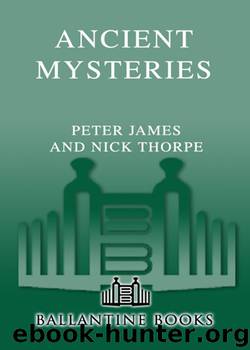Ancient Mysteries by Peter James

Author:Peter James
Language: eng
Format: epub
Tags: History
ISBN: 9780307414601
Publisher: Random House Publishing Group
Published: 2007-12-18T05:00:00+00:00
Church ley lines in Oxford, as envisaged by Alfred Watkins.
While he has collected some intriguing snippets of British folklore in support of his theory, Devereux has yet to prove his case about “spirit lines.” It is easy to imagine that if people believed spirits moved in straight lines, then tracks might be marked out in order to guide ghosts safely from a given village to a graveyard. And one can see how that idea may have evolved into customs of carrying actual corpses along the same routes. But why should graveyards themselves be connected? To facilitate communication or gatherings between the dead? German “ley hunter” Ulrich Magin has taken a completely different approach to church alignments. Researching those in his homeland, he argues that many may have arisen from a deliberate practice, in early medieval times, of positioning churches at cardinal points with respect to a cathedral. Thus churches might be built respectively to the north, south, east, and west of a cathedral, creating a “cathedral cross.” As time went on the alignments might multiply. Magin claims to have found seven churches at Worms on a line only two miles long, one-third of which follows the course of a road. The practice, he stresses, is strictly medieval, and has nothing to do with Watkins’s idea of how special sites “evolved” or changed their purpose from prehistoric times onward. He also distinguishes these alignments from Devereux’s theory of cemetery lines: “These church lines were not for the dead, but for the holy spirit, enhancing the power of the cathedral.”
Speculative though they are, the new approaches taken by Devereux and others are surely worth investigating—and this the ley hunters can be relied on to do. There may have been, and there still will be, many false leads and false trails, but intense fieldwork is the best way to include every relevant monument or local tradition.
It would be pure arrogance to imagine that there is nothing more to be discovered about the ways that ancient people—whether in the Neolithic or the Middle Ages—arranged their sacred monuments. Here old-fashioned ley hunting may still come into its own, as few people have so dedicatedly tramped through the muddy fields of Britain and continental Europe as the disciples of Watkins, or know every bump and stone on the landscape so intimately. Perhaps it is time for archaeologists and ley hunters to bury the hatchet and start pooling their resources and knowledge. The results may be interesting.
Download
This site does not store any files on its server. We only index and link to content provided by other sites. Please contact the content providers to delete copyright contents if any and email us, we'll remove relevant links or contents immediately.
| Africa | Americas |
| Arctic & Antarctica | Asia |
| Australia & Oceania | Europe |
| Middle East | Russia |
| United States | World |
| Ancient Civilizations | Military |
| Historical Study & Educational Resources |
The Daily Stoic by Holiday Ryan & Hanselman Stephen(3109)
The Fate of Rome: Climate, Disease, and the End of an Empire (The Princeton History of the Ancient World) by Kyle Harper(2870)
People of the Earth: An Introduction to World Prehistory by Dr. Brian Fagan & Nadia Durrani(2619)
Ancient Worlds by Michael Scott(2492)
Babylon's Ark by Lawrence Anthony(2430)
Foreign Devils on the Silk Road: The Search for the Lost Treasures of Central Asia by Peter Hopkirk(2387)
The Daily Stoic by Ryan Holiday & Stephen Hanselman(2343)
India's Ancient Past by R.S. Sharma(2295)
MOSES THE EGYPTIAN by Jan Assmann(2275)
The Complete Dead Sea Scrolls in English (7th Edition) (Penguin Classics) by Geza Vermes(2135)
Lost Technologies of Ancient Egypt by Christopher Dunn(2111)
The Earth Chronicles Handbook by Zecharia Sitchin(2101)
24 Hours in Ancient Rome by Philip Matyszak(1973)
Alexander the Great by Philip Freeman(1960)
Aztec by Gary Jennings(1877)
The Nine Waves of Creation by Carl Johan Calleman(1783)
Curse Tablets and Binding Spells from the Ancient World by Gager John G.;(1768)
Before Atlantis by Frank Joseph(1740)
Earthmare: The Lost Book of Wars by Cergat(1715)
